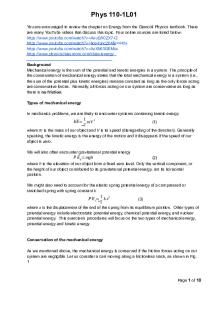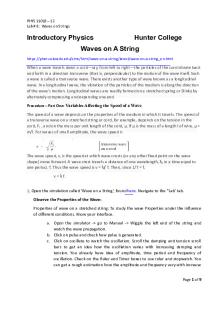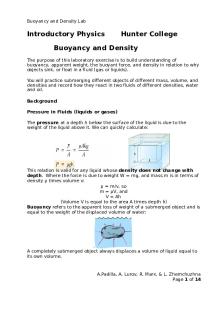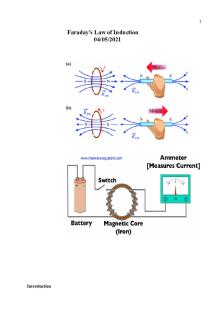Phys lab 5 - Lab report PDF

| Title | Phys lab 5 - Lab report |
|---|---|
| Author | Jeffrey Jakubz |
| Course | General Physics: Introductory Course In Mechanics Heat And Sound |
| Institution | Hunter College CUNY |
| Pages | 10 |
| File Size | 717.7 KB |
| File Type | |
| Total Downloads | 54 |
| Total Views | 189 |
Summary
Lab report...
Description
Phys 110-1L01 You are encouraged to review the chapter on Energy from the Giancoli Physics textbook. There are many YouTube videos that discuss this topic. Four online sources are listed below: https://www.youtube.com/watch?v=AnuLW0ZX7-Q https://www.youtube.com/watch?v=hce4pncZlI4&t=445s https://www.youtube.com/watch?v=AzXb63GEMss https://www.physicsclassroom.com/class/energy Background Mechanical energy is the sum of the potential and kinetic energies in a system. The principle of the conservation of mechanical energy states that the total mechanical energy in a system (i.e., the sum of the potential plus kinetic energies) remains constant as long as the only forces acting are conservative forces. Normally, all forces acting on our system are conservative as long as there is no friction. Types of mechanical energy In mechanics problems, we are likely to encounter systems containing kinetic energy
1 KE= m V 2 2
(1)
where m is the mass of our object and V is its speed (disregarding of the direction). Generally speaking, the kinetic energy is the energy of the motion and it disappears if the speed of our object is zero. We will also often encounter gravitational potential energy
P E g=mgh
(2) where h is the elevation of our object from a fixed zero level. Only the vertical component, or the height of our object contributed to its gravitational potential energy, not its horizontal position. We might also need to account for the elastic spring potential energy of a compressed or stretched spring with spring constant k
1 2 P E s= k x 2
(3)
where x is the displacement of the end of the spring from its equilibrium position. Other types of potential energy include electrostatic potential energy, chemical potential energy, and nuclear potential energy. This exercise’s procedures will focus on the two types of mechanical energy, potential energy and kinetic energy.
Conservation of the mechanical energy As we mentioned above, the mechanical energy is conserved if the friction forces acting on our system are negligible. Let us consider a cart moving along a frictionless track, as shown in Fig. 1
Page 1 of 10
... Figure 1: Conservation of mechanical energy (potential + kinetic) on a track. The bar charts show the amount of the potential and kinetic energies in different points of the track. Its potential energy P E g =mgh total energy is conserved
depends only on its vertical position h along the track. If the
PE ( h )+ KE ( v )= Etot = const .(4) the kinetic of the cart could be found as
KE=Etot −mgh
(5)
where the total energy of the cart is equal to its potential energy at the highest point, where the cart is not moving and, therefore, its kinetic energy is zero
E tot=PE(h max )=mg hmax
(6)
Once the kinetic energy KE of our cart is known, its speed could be found from the definition of kinetic energy as
√
v=
2 KE m
(7)
If the energy is conserved, the potential energy is transferred to the kinetic and back so that the potential energy in the lowest point of the track is zero, and the total energy is equal to the potential one. If the friction force is present, the work of friction is negative and proportional to the distance which our cart has traveled along the track
W f =fd cosπ =−fd where f is the friction force. The total energy keeps constantly decreasing while our cart is moving along the track until it comes to a full stop. Procedure 1. Open the Energy Skate Park simulation https://phet.colorado.edu/sims/html/energy-skate-park-basics/latest/energy-skate-parkbasics_en.html 2. Choose the Intro tab on the left
. Your screen should look like this. Page 2 of 10
3. Set the mass of the skater to the lowest value by sliding the Mass control all the way to the left . 4. Click and drag the skater to place him on the highest point on the left side of the track. 5. Now click the play button at the bottom center of the screen. The skater will demonstrate periodic motion along the track, up and down. Note that the red dot on the skateboard is the reference point for any position.
Page 3 of 10
6. Sketch PE and KE on the same graph with height h on the x-axis and energies on the yaxis. ● PE(h) and kinetic energy KE(h) as skater descends on from the left ● PE(h) and kinetic energy KE(h) as the skater ascends to the right.
7. Enable all the checkmarks Pie Chart, Bar Chart, Grid and Speed in the top right corner of your screen, which will now look like this.
Figure 3: 8. How does the total mechanical energy change with time? The total mechanical energy remains the same. ● How do you determine the Potential Energy PE? You would multiply mass, gravity, and height. ● How would you determine the KE of the skater at any point where you would know h and the mass of the skater? You would subtract the PE from total mechanical energy to get KE. 9. Let the mass of a skater to be m1 = 30 kg. Calculate its potential energy at h = 6m, 5m, 4m, 3m, 2m 1m and 0 using Eq. 2, for the left side of the track only. Record your results in Table 1. Page 4 of 10
Table 1. Potential energy of the skater as a function of his/her height on the track. Height h (m)
6m
5m
4m
3m
2m
1m
0m
PE= mgh (J)
1764
1470
1176
882
588
294
0
Sample calculation: PE = mgh = 30kg*9.8m/s2*6m = 1,764 J 10. How much should the total Mechanical Energy of this system be? If the maximum height is 6m, the total mechanical energy of this system is 1,764 Joules. 11. Based on the conservation of mechanical energy expressed in Eq. (5), determine the kinetic energy of the skater at points h = 6m, 5m, 4m, 3m, 2m 1m and 0, for the left side of the track only, and record your results in the top row of Table 2, below. 12. Then determine the speeds of the skater using the KE equation # 7 at each height. Record the results in the second row of Table 2. 13. Now using the pause and step controls of the simulation record the speed indicated by the round speedometer. Each division on the speedometer represents one meter per second from 0 to 20m/s. Enter values closest to the nearest 0.5 m/s. Record the values in the bottom row. Again, only use the left side of the track. 14. How close were the two rows of speed? The values of the two rows of speeds were very close. The calculated value may be somewhat more precise as the speed of the speedometer may not be exactly at those heights. Table 2. Kinetic energy and velocity of the skater as a function of his/her height on the track. Height h [m] 6m 5m 4m 3m 2m 1m 0m KE(h) [J]
0
294
588
882
1176
1470
1764
V [m/s] Calculated
0
4.42
6.26
7.67
8.85
9.9
10.84
V [m/s] Speedometer
0
4.3
6.2
7.85
8.95
10
10.9
ME-PE
Sample calculation: ETotal = PE + KE, KE (1 meter) = 1,764J – 294J = 1470J V=
√
√
2∗1470 J 2 KE = =10.84 m 30
m/s
15. How closely do the values of the calculated and recorded speed match? The values are very close to the calculated values. As these are rough estimate readings, they may be the same as the calculated ones. 16. Add up the total values of the 6 speeds for the calculated and speedometer values. Find the percent difference between them. Abs { ΣV exp−ΣV speed } ------------------------------ x 100% = | 47.94 m/s – 48.2 m/s | / 48.2 m/s = 0.54%
ΣV speed . 17. Now using the data from Tables 1 and 2, plot PE, KE and Total energy, Etot on the same graph vs. position h, at the heights of 6m,5m,4m,3m,2m,1m, and 0m. Put height on the x-axis and energies on the y-axis. Use the red dot on the skateboard to guide you to the appropriate height. Clearly indicate which energy each line represents. Page 5 of 10
18. By freehand try to draw a line of best fit. Remember it may not be a straight line. Also, the line of best fit does not have to touch all the plotted points. How do these graphs compare to the first half of the sketches you originally made in Step 6, when the skater descends?
Energy vs Height Energy (Joules)
2000 1500 1000 500 0
0
1
2
3
4
5
6
Height (meters) Kinetic Energy
Potential Energy
19. Now slide the Mass lever to the right to obtain the greatest mass. 20. Play the simulation. 21. Record the speed of the speedometer at heights of 6m, 5m, 4m, 3m, 2m, 1m and 0m in Table 3. Table 3. Speed of the Large Mass Skater Height h [m]
6m
5m
4m
3m
2m
1m
0m
Vexp, m/s
0
4.1
6.1
7.1
8.95
10
11.1
Large Mass
22. How does the speed for the larger mass skater compare with the lower mass skater? The greater the mass, the higher the speed. 23. Now let’s explore motion on a different track; see track options on the lower right of the screen.
24. Select the track with two dips
by clicking on it.
25. Set the mass of the skater to the smallest value. 26. Place the skater on the left highest point.
Page 6 of 10
27. Play the simulation with the Slow-Motion option and observe the speed variations on the speedometer. 28. As the speed changes, describe the patterns of changes in PE, KE and Etot. As the speed decreases, the PE increases, the KE decreases, and the Etot remains the same, and the opposite happens as speed increases. 29. Now record the speedometer's speed of the skater at heights of 2 m, on the left of the hill, at the hill, and to the right of the hill. Note: Use the Pause and Forward buttons to attain the desired positions.
Page 7 of 10
Table 4. Speed of the Skater at a height of 2 m Left of hill, h = 2m At the hill, h = 2m Speed v = 7.8 m/s Speed v = 7.8 m/s
Right of hill, h = 2m Speed v = 7.8 m/s
30. What can you conclude about the data you just recorded? The speed is the same at any given height. 31. Explain how the total energy and speed of the skater changes with time in the presence of friction. In the presence of friction, the speed of the skater decreases until they become zero as time passes, however total energy stays the same throughout, as the mechanical energy converts into thermal energy. 32. Click on the Friction window at the bottom of your screen
.
33. Select all the options for grid, speed, bar graph, and pie chart. 34. Set the mass to the minimum value and friction at the middle value.
35. Let the mass of the skater be 30 kg, play the simulation and observe the skater.
Page 8 of 10
36. Describe how the mechanical energy of the skater changes over time. The mechanical energy slowly decreases over time, and changes into thermal energy. 37. Now, press the Pause tab and return the skater to the top left of the track. 38. Using the forward button, record 6 speeds from the speedometer of the skater from start to finish in Table 5. Choose points where you can identify the speed and the heights fairly accurately, either from the left or right side of the track. The first point must be at the start of the motion and the last data point must be when the skater comes to a complete stop. The first and last entries are already entered in the table.
39. Complete Table 5 by calculating the PE, KE, and Total Mechanical Energy of the Skater. Table 5. Mechanical Energy of the Skater w/Friction Time Height m Speed m/s PE KE Emech-tot T1 6 0 1764J 0J 0J T2
5.5
3
1617J
135J
-12J
T3
5
4.1
1470J
252.2J
-41.8J
T4
4
6
1176J
540J
-48J
T5
3
7.4
882J
821.4J
-60.6J
T6
2
8.6
588J
1109.4J
66.6J
T7
1
9.6
294J
1382.4J
-87.6J
T8
0
0
0J
0J
-1764J
Sample calculations: PE (1m/left side) = 30kg * 1m * 9.8m/s2 = 294J KE = ½ mv2 = ½ * 30kg * 9.6 m/s = 1382.4 J Mechanical Energy = 1382.4J + 294J = 1676.4J Page 9 of 10
Emech-tot = 1676.4J - 1764J = -87.6J 40. How much total Mechanical Energy of this system start off with? Show your calculation. The Mechanical energy at the start is: PE = mgh = 5m * 9.8m/s2 * 30kg = 1470J EMech = 1470J – 0J = 1470J 41. How much total Mechanical Energy was lost by the end of the skater’s motion? Why? 1764J – 1560.6J = 203.4J; 203.4J are lost due to force of friction pulling the skateboard backwards each second the skateboard moves. 42. Does the loss of Mechanical Energy violate the Law of Conservation of Energy? Explain. This loss of mechanical energy does not violate the Law of Conservation of Energy. Even though the total mechanical energy continues to decrease, this energy is converted into thermal energy, and so the total amount of Joules remains the same. 43. Plot the energy loss due to friction and total mechanical energy on the same graph vs time; use T1 – T8 as your times, from Table 5. So, instead of having specific times in seconds your x-axis will just state T1, T2, T3, etc.
44. According to your graph, how much thermal energy was gained by the system? According to this graph, as 203.4J of mechanical energy was lost, 203.4J thermal energy was gained. 45. Where did the thermal energy come from? As friction is the force that occurs from the surfaces of two objects touching, the molecules that rub with one another move faster, and produce thermal energy. 46. Based on your results, what can you conclude about the change of the total energy of the system over time in the presence of friction? Explain. Based on these results, with the presence of friction, the total energy of the system remains the same over time, however the mechanical energy is changed into thermal energy.
Page 10 of 10...
Similar Free PDFs

Phys lab 5 - Lab report
- 10 Pages

Phys lab 4 - Lab report
- 10 Pages

Phys lab 8 - Lab report
- 9 Pages

Phys lab 10 - Lab report
- 14 Pages

Phys lab report 2
- 14 Pages

PHYS Lab Report 3
- 7 Pages

Phys lab 6 - Lab report 6
- 13 Pages

LAB 5 - Lab report
- 4 Pages

Lab Report 5 - lab
- 5 Pages

Phys 208 Lab Report # 3
- 3 Pages

LAB Report #4 phys 224
- 5 Pages

PHYS 215 Vectors - Lab Report
- 2 Pages

Lab 5 - Lab report
- 6 Pages

Lab report 4 int phys
- 4 Pages

Lab 5 - Lab experiment report
- 6 Pages
Popular Institutions
- Tinajero National High School - Annex
- Politeknik Caltex Riau
- Yokohama City University
- SGT University
- University of Al-Qadisiyah
- Divine Word College of Vigan
- Techniek College Rotterdam
- Universidade de Santiago
- Universiti Teknologi MARA Cawangan Johor Kampus Pasir Gudang
- Poltekkes Kemenkes Yogyakarta
- Baguio City National High School
- Colegio san marcos
- preparatoria uno
- Centro de Bachillerato Tecnológico Industrial y de Servicios No. 107
- Dalian Maritime University
- Quang Trung Secondary School
- Colegio Tecnológico en Informática
- Corporación Regional de Educación Superior
- Grupo CEDVA
- Dar Al Uloom University
- Centro de Estudios Preuniversitarios de la Universidad Nacional de Ingeniería
- 上智大学
- Aakash International School, Nuna Majara
- San Felipe Neri Catholic School
- Kang Chiao International School - New Taipei City
- Misamis Occidental National High School
- Institución Educativa Escuela Normal Juan Ladrilleros
- Kolehiyo ng Pantukan
- Batanes State College
- Instituto Continental
- Sekolah Menengah Kejuruan Kesehatan Kaltara (Tarakan)
- Colegio de La Inmaculada Concepcion - Cebu
